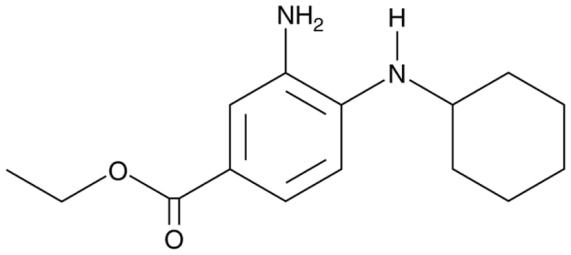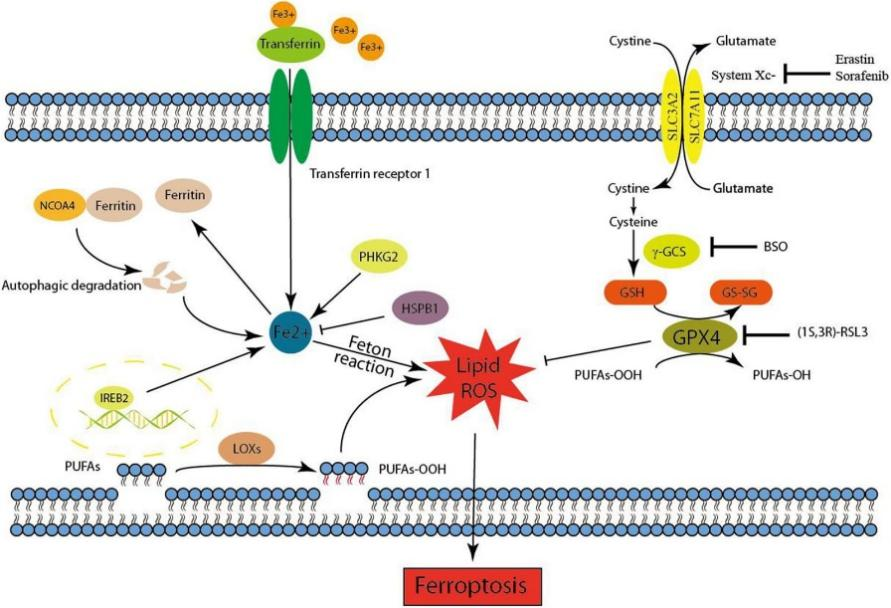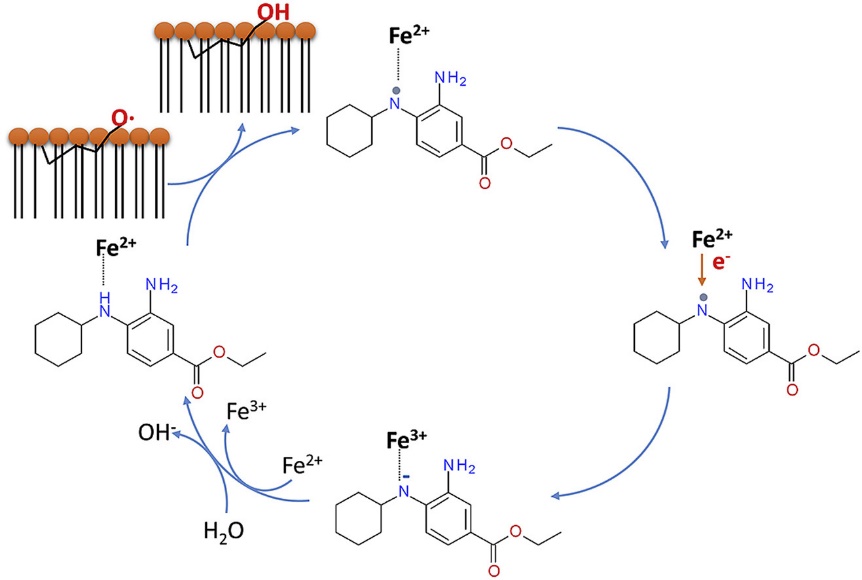FERROSTATIN 1
INTRODUCTION
As we know, in general, reactive Oxygen species (ROS) are essential for the normal biological functions of cells but on other hand, they are also involved in cellular degeneration and tissue death. So, there is a basic need for such chemical or compound which is antioxidant in nature and very specific in its functions to combat the production of ROS (which induces cellular death) without altering the production of normal ROS that are required for cellular functions. That’s why Ferostatin-1 is developed. It is a very potent chemical agent for inhibiting ferroptosis which is defined as an oxidative, somewhat regulated, and nonapoptotic death of a cell.

Figure 1: Ferrostatin 1 structural formula
FERROPTOSIS AND ITS MECHANISM OF ACTION
In general, the word Ferro means Fe and the word ptosis means falling. It is a type of cell death in which there will be an increase in the accumulation of iron within the cell that will induce the production of reactive oxygen species. These reactive oxygen species overwhelmed the glutathione-dependent antioxidant mechanism. This mechanism induced the abnormal Lipid peroxidation of the cell membrane which causes a decrease in membrane permeability. This loss of membrane permeability and reactive oxygen species leads to cell death. There are the transferrin membrane receptors on the surface of the cell membrane that allow the binding of Fe3+ to the membrane and endocytosed it to the cytoplasm. In the resulting endosome, a ferric form of iron Fe3+ is converted into ferrous form Fe2+ by an enzyme called STEAP3 (six transmembrane epithelial antigens of the prostate 3). This Ferrous form of iron now moves from the endosome to the cytoplasm of the cell through DMT1 (divalent metal transporter 1). This increase in the concentration of Fe2+ makes a labile pool in the cytosol. This iron is non-protein bounded, in redox active form, and used in cellular processes. Now another two proteins called PCBP1 and PCBP2 bound this Ferrous form of iron (Fe2+) and stored it in the form of ferritin. Now when it is required, lysosomes degrade it, and then it will combine with PCBP2 protein and be transported to a transporter called ferroportin onto the cell membrane from where its moves outside the cell. So due to the increase in the expression of the gene for transferrin 1 protein, more iron moves inside the cell or due to the dysfunction of PCBP1 and PCBP2 protein and transporter ferroportin, iron accumulates inside the cell, which increases the cytosolic pool of iron . This increase in iron cause cell death. On the other hand, there is an amino acid anti-transporter present on the cell membrane that allows the movement of cystine into the cell along with the outward movement of glutamate. This cystine is converted into cysteine and then with the help of the enzyme gamma-glutamylcysteine synthetase, it is converted into glutamyl cysteine, and then with the reaction with glycine, it will form reduced glutathione which is a potent antioxidant. This reduced glutathione tackles all the reactive oxygen species. Now this reduced glutathione converts into oxidized form for the sake of glutathione peroxidase which converts lipid peroxide to lipid alcohol. Whenever reduced glutathione is required to tackle ROS, glutathione reductase converts back oxidized glutathione to the reduced form. So, whenever the reactive Oxygen species are available, this reduced glutathione will be utilized to tackle these ROS and if these ROS are less, then there will be a surplus amount of reduced glutathione in the cell. Hence if there is no reduced glutathione, then lipid peroxide will not convert into alcohol form. This lipid peroxide is dangerous to cells. These lipid peroxides are formed from polyunsaturated fatty acids with the help of lipoxygenase. The role of iron in the formation of lipid peroxide is that it acts as a co-factor for the functioning of lipoxygenase(Dixon et al., 2012).
When there is excessive accumulation of iron within the cell, it will produce OH- ions with the help of the Fenton reaction. These OH- ions are reactive Oxygen species that will be tackled by reducing glutathione which we have already discussed that it is a major antioxidant of the cell. This decreased level of glutathione results in the no conversation of lipid peroxide to alcohol form. These lipid peroxides cause lipid peroxidation of the cell membrane that in return causes cellular death due to the loss of permeability of the membrane.

Figure 2: Ferroptosis mechanism of action
FERROSTATIN MECHANISM OF ACTION
The potent antioxidant, Ferostatin-1 causes the decrease in the accumulation of iron within the cell. So due to less iron accumulation, there will be no Fenton reaction and no decrease in the reduced glutathione. This high level of glutathione converts the lipid peroxide to lipid alcohol with the help of glutathione peroxidase by converting itself into an oxidized form. On the other side, Fe which acts as a cofactor for the conversation of polyunsaturated fatty acids into lipid peroxide is not available. So, there will be less Lipid peroxide production along with its conversation into lipid alcohol. This mechanism will prevent ferroptosis (cellular death). Ferostatin-1 continues this process without being consumed because, with the help of ferrous ion, it will be reduced back to fer-1 radical(Zilka et al., 2017, Skouta et al., 2014).

Figure 3: Ferrostatin mechanism of action
In cancerous cells, ferroptosis is initiated by several molecules including erastin, RSL3, and sulfasalazine which disturb homeostasis, and in return allow the Fe-dependent accumulation of reactive oxygen species (ROS). In HT 1080 Cells, this erastin inhibits the uptake of Cystine, which is an oxidative form of Amino acid “cysteine” that is a rate-limiting chemical for the formation of tripeptide glutathione (reduced glutathione) which is an antioxidant. This erastin induces the accumulation of reactive oxygen species, which cause cellular death. The role of Fe in this process is unknown, although there are some pieces of evidence that iron acts as a cofactor during the production of reactive oxygen species that cause ferroptosis. When Ferostatin-1 is used at the concentration of 0.5 micromolar, it prevents cell death by suppressing erastin which induces ferroptosis within HT 1080 cells which are human fibrosarcoma cells. Due to its antioxidant property, it inhibits the production of free radicles which in return prevent the death of these cells.
Recently we have discussed that cell undergoes a novel type of death called ferroptosis which is different from phagocytosis and necrosis. Recent studies showed that Ferostatin-1 is beneficial to eliminate the effect of acute lung injuries which are induced by lipopolysaccharides, due to which lung cells undergo ferroptosis. Acute lung injury is a syndrome that includes the disorders of lungs like interstitial edema, lung epithelium injuries, and inflammatory responses like the accumulation of neutrophils. Studies suggest that these lipopolysaccharides are part of the bacterial cell membrane which are the causative agent of ALI. These lipopolysaccharides activate the immunity via the TLR4 pathway which initiates an inflammatory response against agents and the production of reactive oxygen species. The exact mechanism of action is not understood but it is suggested that these causes lipid peroxidation which depends upon Fe availability. So due to lipid peroxidation, mitochondria become shrink, and already produced reactive oxygen species cause cellular death. Ferostatin-1 prevents this lipid peroxidation of the cell membrane which causes the death of cells without interfering with the formation of reactive oxygen species in mitochondria and permeability of the lysosomal membrane(Liu et al., 2020).
Ferostatin-1 is a very potent drug in neurodegenerative disorders like Alzheimer’s disease, Huntington’s disease, and Parkinson’s disease because all these neurodegenerative disorders are associated with the oxidative stress caused by the production of reactive oxygen species in brain cells which is an outcome of dysregulation of homeostasis of Fe. This oxidative stress (caused by ROS) initiates ferroptosis which results in cellular death of brain cells or neurons.
FERROSTATIN ROLE IN NEURODEGENERATIVE DISORDERS
- Alzheimer’s disease is one of the major neurodegenerative disorders which causes dementia due to cognitive dysfunction. The main pathological feature of AD is the deposition of beta-amyloid in the extracellular region and abnormal phosphorylation of Tau proteins in the intracellular environment. Recent studies also suggest that several iron metabolism dysfunctions and oxidative stress caused by ROS are linked with the progression of Alzheimer’s disease. One of the major Hallmark of Alzheimer’s disease is ferroptosis which is initiated by iron dysregulation and lipid peroxidation. So, in the treatment of AD Ferostatin-1 is beneficial because it minimizes the dysregulation of Fe and prevents the production of ROS via reducing pathways which will prevent the cell from death.
- The other most important neurodegenerative disorder is Parkinson’s disease which is characterized by the deprivation of dopaminergic brain cells in the region called substantia nigra (which majorly controls body movements) and the accumulation of Lewy bodies within these cells. Recently it is studied that the Lipid peroxidation of these dopaminergic neurons is a crucial step in the pathogenesis of Parkinson’s disease. It is also studied that the brain cells of substantia nigra which are affected by damage have increased in iron accumulation along with reactive oxygen species. So, the drug which can regulate iron metabolism play important role in the treatment of PD. Ferostatin-1 is one of the potent chemicals which is antioxidant and regulates the iron metabolism within brain cells and prevents them from cellular death.
- Similar to Parkinson’s disease and Alzheimer’s disease, Huntington’s disease is also a neurodegenerative disorder that is associated with the accumulation of Fe along with lipid peroxidation which are the major initiators of ferroptosis so Ferostatin-1 is of major concern related to these neurodegenerative disorders(conner, 2020).













Comments